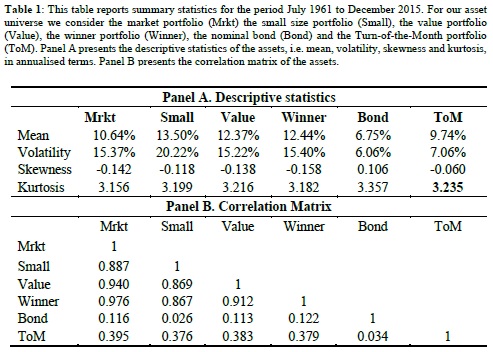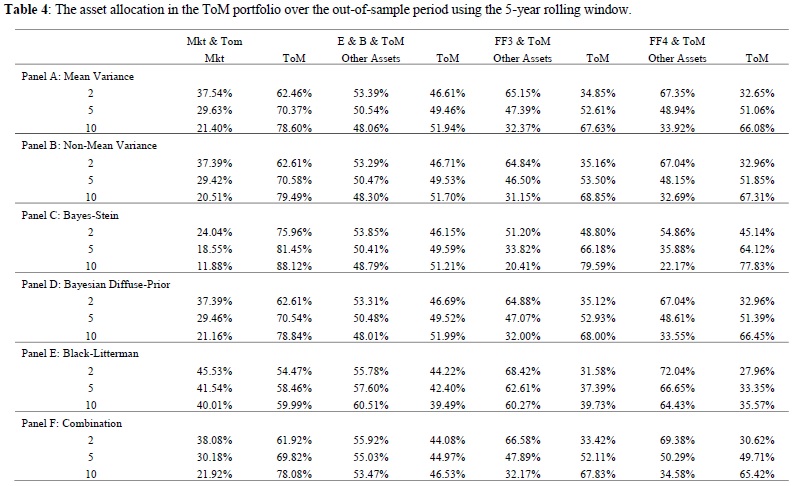
A Turn of the Month Strategy in Asset Allocation
A new research paper related mainly to:
#41 – Turn of the Month in Equity Indexes
Authors: McGroarty, Platanakis, Sakkas, Urquhart
Title: A Seasonality Factor in Asset Allocation
Link: https://papers.ssrn.com/sol3/papers.cfm?abstract_id=3266285
Abstract:
Motivated by the seasonality found in equity returns, we create a Turn-of-the-Month (ToM) allocation strategy in the U.S. equity market and investigate its value in asset allocation. By using a wide variety of portfolio construction techniques in an attempt to address the impact of estimation risk in the input parameters, we show significant out-of-sample benefits from investing in the ToM factor along with a traditional stock-bond portfolio. The out-of-sample benefits remain significant after taking into account transaction costs and by using different rolling estimation windows indicating that a market timing strategy based on the ToM offers substantial benefits to investors when determining the allocation of assets.
Notable quotations from the academic research paper:
"Seasonality is a well-known characteristic of financial markets with much empirical literature noting various types of seasonality in stock returns. Simple seasonality-driven investment strategies have attracted significant interest from academics and investors over the last forty years.
Amongst the calendar effects, the turn-of-the-month (ToM hereafter) has been acknowledged as one of the strongest and persistent seasonality found in stock returns. The ToM effect is the tendency of the stock market returns to display particularly high returns on the last trading day of the month and the first three trading days of the next month.
This study contributes to the literature on calendar anomalies in several dimensions. We examine the out-of-sample portfolio benefits resulting from adding the ToM portfolio to (i) a traditional equity-bond mix, (ii) a market portfolio, (iii) a portfolio which consists of the market portfolio, the small size portfolio and the value portfolio, and (iv) a portfolio, which consists of the market, the small size, the value portfolio and the winner portfolio.

We employ a wide variety of sophisticated and popular asset allocation techniques to provide robustness to our results. Specifically, we employ the mean-variance (Markowitz) portfolio optimization, portfolio optimization with higher moments, Bayes-Stein shrinkage, Bayesian diffuse-prior portfolio, Black-Litterman and another portfolio construction method that combines individual portfolio techniques, to ensure that our results are not just a peculiar artefact on one particular asset allocation technique. Finally, we assess the ToM for low, medium and high-risk averse investors, as its effectiveness in the portfolio might depend on the investor’s level of risk aversion.
Our empirical evidence suggests that the ToM portfolio adds value when included in different portfolios. Our results hold for different levels of risk aversion, portfolio techniques and estimation windows. Finally, our results are not eliminated by the including realistic transaction cost estimates, indicating that the creation and implementation of a ToM factor should be of great interest and potential value to investors.
 "
"
Are you looking for more strategies to read about? Sign up for our newsletter or visit our Blog or Screener.
Do you want to learn more about Quantpedia Premium service? Check how Quantpedia works, our mission and Premium pricing offer.
Do you want to learn more about Quantpedia Pro service? Check its description, watch videos, review reporting capabilities and visit our pricing offer.
Are you looking for historical data or backtesting platforms? Check our list of Algo Trading Discounts.
Would you like free access to our services? Then, open an account with Lightspeed and enjoy one year of Quantpedia Premium at no cost.
Or follow us on:
Facebook Group, Facebook Page, Twitter, Linkedin, Medium or Youtube
Share onLinkedInTwitterFacebookRefer to a friend

















